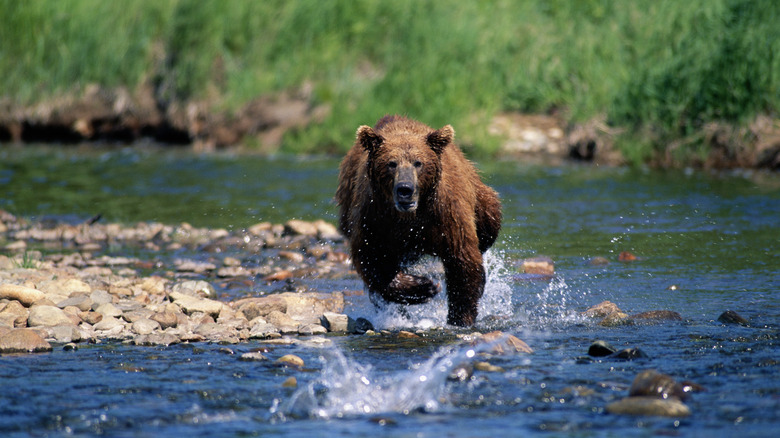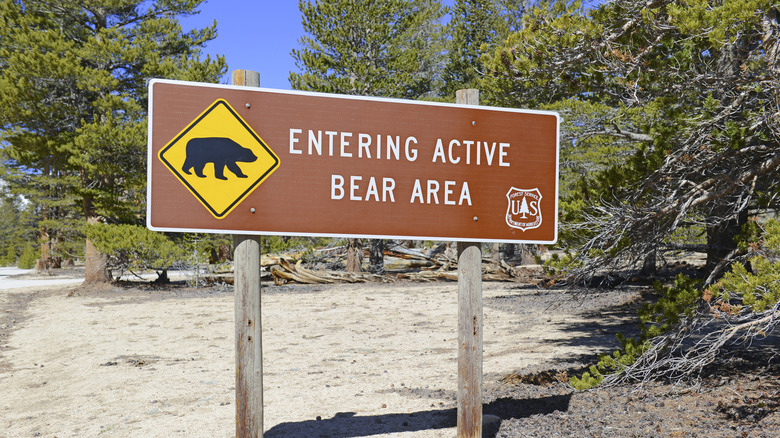What Is A Bear Aggressive Charge And What Should You Do?
Given that 40 states in the U.S. as well as all the provinces and territories in Canada are home to a population of dangerous bears, odds are anyone spending much time in the outdoors here will at some point see one of these massive mammals. This is particularly true during the warmer months of summer and fall since that's when you are more likely to run into a bear. While there are ways to reduce the risk of an encounter, such as making noise to avoid bears, any excursion into bear territory has a risk of not just seeing a bear but perhaps having what is known as a negative encounter with one. These incidents are any aggressive interaction with a bear, such as a charge or, worse, an attack.
Before adventuring in bear country, it is best to know what to do if attacked by a bear and, more importantly, how to avoid such an encounter. To that end, a large part of staying safe around bears is recognizing the danger signs and when a bear is becoming agitated or aggressive. While keeping a safe distance helps, a bear can quickly cover a surprising amount of ground when they charge. However, not all of these charges are an attempt to attack. So, what is a "bear aggressive charge" and what should you do?
Difference between bluff charge and aggressive charge
If bears hear you coming, usually they will flee before you see them. However, if you do happen to somehow find yourself face-to-face with a bear, it is important to pay close attention to its behavior. It is important not to panic and stand your ground while observing the bear. You can also speak to it in a calm manner. Never, ever run, as this encourages a bear to chase. However, if you start seeing signs a bear is becoming agitated –- pacing, clacking teeth, drooling, vocalizing, pawing the ground, etc. -– you need to prepare yourself in case it charges.
If the bear charges, it doesn't necessarily mean it is going to attack. Quite often, a bear bluff charges in an attempt to scare away what it perceives as a threat. While a bluff charge is indeed scary, some of the signs that it is only a bluff and not an intended attack are the bear will be bounding or hopping and may veer off or retreat well short of you. Additionally, during a bluff charge, the bear's head will be up and its ears will be pointed forward. An aggressive charge, on the other hand, is a very dangerous situation. Before launching an aggressive charge, a bear will often yawn or clack its teeth. Once it begins an aggressive charge, it will be coming full steam with its head down and ears back.
What you should do if a bear aggressively charges you
As hard as it may be to resist the urge, if a bear does aggressively charge, do not run. Grizzly bears are capable of speeds up to 40 miles per hour. The average sprint speed for athletes is 18 miles an hour. Needless to say, you have zero chance of outrunning a charging bear. So, your best chance for survival is to stay right where you are and accurately determine what type of bear is charging you — it's likely to be a grizzly or black bear. Why is the species important? Because your reaction should be based on the type of bear that is attacking.
If a black bear is charging, prepare to fight. Make yourself look as large as possible, take an aggressive stance, and yell loudly. This may dissuade it from attacking. If the bear continues its charge and does attack, fight back with all you have and use anything you can grab as a weapon. If you are carrying bear spray, use it. On the other hand, if a grizzly is aggressively charging, you do not want to engage in a fight. Once the charging bear is in range, discharge a cloud of bear mace if you have it. Then, fall to the ground and play dead — lay face down, leave your pack on for added protection, cover your head and neck, spread your legs apart, and try not to make any noise. If the grizzly continues to attack, as a last resort fight back.


